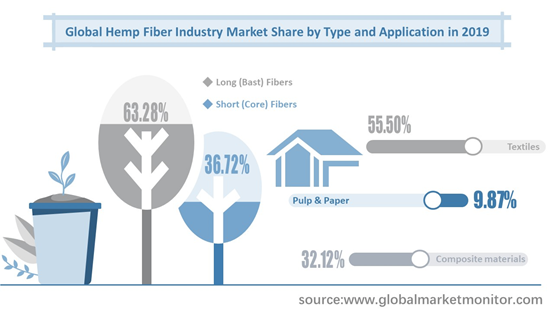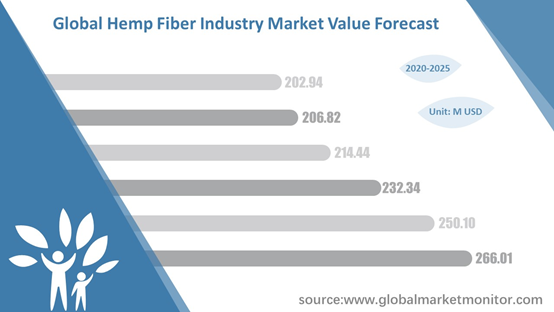Hemp is a
bast fiber plant with various excellent properties to be used to process
textiles, pulp and paper, composite materials, etc., which is in great demand
in daily life. Hemp stems contain two types of fibers: long (bast) fibers and
short (core) fibers. The long and strong bast fibers are 5-40 mm long and
combine into fiber bundles of 1-5 m long, similar to cork fibers, with very low
lignin content. The short (core) fiber is only about 0.55 mm, just like
hardwood fiber and a large amount of lignin bonded together. For high-grade
paper applications, people generally think that a length of 3mm is the most
ideal, but the core fiber is too short and there is too much lignin. Therefore,
long (bast) fibers have been used in papermaking for a long time, but short
(core) fibers are rarely used.

Bast fiber can be washed, spun, and then woven into fabrics to make clothes and household products, which has the characteristics of durability, strong air permeability, strong warmth retention, strong mildew resistance and hypoallergenicity. Hemp fiber can also be mixed with other fibers, such as cotton and linen, to obtain specific textures and properties. In addition, the long (bast) fiber of hemp is also an ideal choice for making high-quality pulp. Because of their high tensile strength, they are very suitable for making high-end specialty paper products, such as tea bags, currency paper, cigarette paper or special filters. According to the existing pulping technology for effectively processing hemp, the hemp core and full rod can also be used to manufacture low-end paper products. Similar to textiles, hemp fiber can be mixed with other pulp fibers (such as wheat straw or flax, or even recycled wood) to improve paper performance, strength, and recyclability. Hemp core fiber can also be used to make composite materials such as density fiberboard, hemp building blocks, hemp cement or hemp concrete. Environmentally friendly hemp building materials can also capture carbon dioxide. Overall, the textile industry hemp fiber market is the broadest, with a market share of 55.50% in 2019, followed by composite materials with a market share of 32.12%.
Prospect Analysis of Hemp Fiber Industry in Various Regions
After a period of development, the industry is in a growth period. With the continuous upgrading of products, the expansion of downstream industries and the development of economy and technology, the market continues to expand. The hemp fiber market has become a highly competitive international market with relatively high market concentration. Hemp fiber companies mainly come from China, Europe and the United States. In 2019, the top three companies, Shanxi Greenland Textile, Shenyangbeijiang, Dun Agro, have a total market share of 44.58%, and market share of 22.90%, 11.58%, and 10.09%, respectively.
As a country with a large population, China has a great demand for textiles, paper and composite materials. As one of the raw materials for processing these products, hemp fiber is also in great demand. China has become the largest revenue market in the hemp fiber industry, with a market share of 45.14% in 2015 and 45.67% in 2019, an increase of 0.53%. fertile soil of China can produce high-quality hemp, which helps to extract high-quality hemp fiber. In addition, the labor force in our country is very rich, and the manufacturing of the hemp fiber industry requires a large number of factories and labor, which can promote the rapid development of the hemp fiber industry.
Get the Complete Sample, Please Click: https://www.globalmarketmonitor.com/reports/762795-hemp-fiber-market-report.html
The textile industry in Europe is relatively developed and there is a great demand for hemp fiber. In 2019, the European market share was 19.60%, ranking second. Taking into account various factors, the governments of many European countries have very high restrictions on the cultivation of hemp and strict requirements on the quality of hemp, which restricts the development of the hemp industry.
However, with the legalization of hemp in parts of the United States and Canada, many countries and regions have begun to change their perceptions of hemp. The demand for hemp continues to increase and the industry is developing rapidly. Active local policies have promoted the growth of the U.S. hemp fiber market, and the United States is expected to become an emerging market for the hemp fiber industry.
The Development of the Internet Will Promote the Intelligence and Digitization of Hemp Fiber
The hemp fiber industry is mainly affected by the hemp industry, textile industry, paper industry and composite raw material industry. The growth of consumer demand and GDP growth has promoted the development of the hemp fiber industry. In addition, with the improvement of human awareness of environmental protection, hemp fiber, as a new type of natural material, has developed different uses. Hemp fiber is longer, stronger, more water-absorbing, more resistant to mold, more insulating than cotton fiber, and feels better to use, so the demand for hemp fiber is also increasing.

According
to our research, the global hemp fiber market has a total revenue of 172.42 M
USD back in 2015, and increased to 201.81 M USD in 2019. We made the prediction
that the value of hemp fiber markets can be 266.01 M USD by 2025. The CAGR of
hemp fiber is 5.56% from 2020 to 2025.
With the
rapid development of the Internet, hemp cultivation is becoming digital and
intelligent. The hemp traceability system Leaf Data System(LDS) has been fully
implemented in Washington State. The development of this new hemp planting
system will help farmers grow hemp, extract hemp fiber, and improve the quality
of hemp fiber, thereby increasing the demand for hemp fiber.
The hemp
fiber industry is a growth industry. With the expansion of the application
range of hemp fiber, the government policy on hemp has begun to change in a
positive direction, which will promote the development of the hemp fiber
industry. The intelligence and digitization of hemp cultivation will also bring
new development opportunities to the hemp fiber industry.
We provide more professional and intelligent market reports to complement your business decisions.